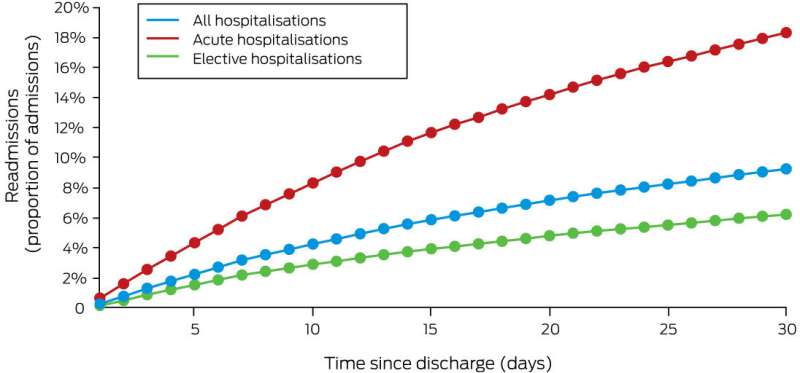Peripheral arterial disease: Hospital readmissions common, often potentially preventable

About 10 percent of patients hospitalized in Australia and New Zealand with peripheral arterial disease (PAD) unexpectedly return to hospital within 30 days, often for potentially preventable reasons, according to research published today by the Medical Journal of Australia.
Early symptoms of PAD include limb pain during movement, and progression of atherosclerosis can lead to chronic limb-threatening ischaemia—manifested as rest pain, ischaemia with ulceration, gangrene, and infection—that often necessitates limb amputation. People with PAD typically have poor clinical outcomes, including substantial loss of mobility and elevated risks of stroke, myocardial infarction, and death.
Researchers from Flinders University, the Royal Adelaide Hospital and the University of Queensland analyzed hospitalisations data for adults (18 years or older) hospitalized with a primary or secondary diagnosis of PAD between 1 January 2010 and 31 December 2015.
"Of 104,979 admissions included in our analysis, 9765 were followed by at least one unplanned readmission within 30 days of discharge (9.3 percent). Unexpected readmissions were even more common among those patients who had an acute PAD hospitalization, where the readmission rate reached 18.4 percent. Of all those readmitted 3395 occurred within one week (34.8 percent) and 7828 within three weeks (80.2 percent), meaning that most readmissions occurred soon after the initial hospitalization," reported the authors, led by Ms Vanessa Woelk, a research scientist with Flinders University's International Centre for Point-of-Care Testing.
"Readmission was more frequent after acute (18.4 percent) than elective PAD hospitalization (6.3 percent), but the characteristics of readmissions were similar. Factors associated with greater likelihood of readmission included acute PAD hospitalisations, surgical intervention during the PAD hospitalization, and chronic limb-threatening ischaemia.
"The most frequent readmission primary diagnoses were atherosclerosis (1,477, 15.3 percent), type 2 diabetes (1,057, 10.8 percent), and 'complications of procedures not elsewhere classified' (963, 9.9 percent) although many readmissions occurred for potentially avoidable reasons such as procedural complications, cardiovascular events, and infections," wrote Woelk and colleagues.
"The incidence of these complications could be reduced by improving peri-operative care and quality control measures.
"Infections such as cellulitis, pneumonia, and sepsis were also frequent readmission diagnoses, and targeted interventions could avert these potentially avoidable conditions.
"The primary readmission diagnoses were heart failure, acute myocardial infarction, angina, or stroke, reflecting the risk of cardiovascular events associated with PAD. Aggressive primary and secondary prevention of cardiovascular disease may improve outcomes for patients with PAD."
"More broadly speaking, improving discharge and hospital-to-home care transition practices, such as pro-active discharge planning, patient education, routine early follow-up, and pharmacist review of medications has been reported to reduce readmission and emergency department visits by 30 percent, with substantial cost savings."
Woelk and colleagues concluded that in Australia and New Zealand, 9.3 percent of admissions for the treatment of PAD during 2010–2015, including 18.4 percent of acute admissions, were followed by unplanned readmissions within 30 days of discharge.
"PAD is a common condition. Our research suggests there are considerably opportunities to reduce unplanned readmissions, to improve clinical outcomes for people with PAD, and to reduce healthcare costs," they wrote.
More information: Vanessa Woelk et al, Incidence and causes of early unplanned readmission after hospitalisation with peripheral arterial disease in Australia and New Zealand, Medical Journal of Australia (2021). DOI: 10.5694/mja2.51329



















